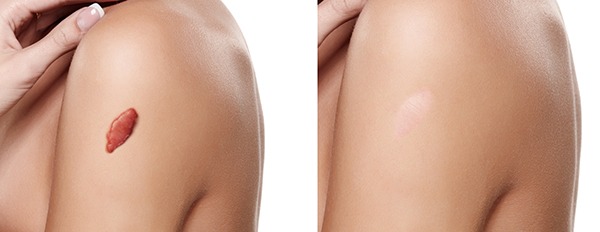 Scars are the marks that are left on the skin after an injury has healed. Scars can be caused by trauma, cuts, burns, acne, and skin related diseases like lupus or chickenpox. Scars are thicker, and shinier than normal skin and can appear anywhere on the body. They are usually red or pink in colour. Scars do not immediately disappear but fade in time. To make a scar as invisible as possible requires extra effort from both the patient and the doctor.
Scars are the marks that are left on the skin after an injury has healed. Scars can be caused by trauma, cuts, burns, acne, and skin related diseases like lupus or chickenpox. Scars are thicker, and shinier than normal skin and can appear anywhere on the body. They are usually red or pink in colour. Scars do not immediately disappear but fade in time. To make a scar as invisible as possible requires extra effort from both the patient and the doctor.
There are different types of scars which are mentioned below:
- Keloid scar: these are thick, raised, and are often red or dark in color. They are caused by the over production of collagen that grows beyond the wound.
- Hypertrophic scars: these are also thick, red, and are raised. But unlike keloid scars they do not grow over the wound but instead remain within their boundary.
- Contractures: This occurs when the elastic nature of the skin is replaced with fibers which make the skin more rigid losing the ability to stretch and restricting movement. This can occur with burns or with the loss of a large area of skin from injury.
Non-surgical treatment includes:
- Creams or lotions Vitamin A, Vitamin E, or retinoic acid can be applied to the scar to improve the appearance and surface of the scar.
- Steroids- either topical or injections into the scar help the scar to flatten and soften
- Anti-mitotic agents (5-fluorouracil or bleomycin) prevent the cells from dividing in the scar region so that the scar will not spread. These anti-mitotic injections are not used in pregnant women.
- Laser/IPL therapy – This is used together with creams or injections to reduce the redness, flatten and improve the appearance of scars. Multiple treatments are usually required.
- Fillers such as hyaluronic acid are used for treating scars that have a depressed surface, with the goal of leaving behind an unnoticeable scar. A topical anaesthetic cream is applied before the treatment.
- Surgical treatment may improve the appearance of scars and the risks and benefits of this option can be discussed at your appointment.
